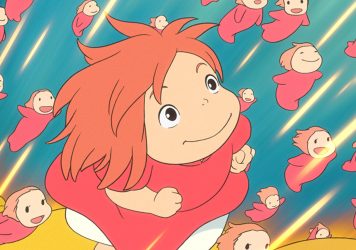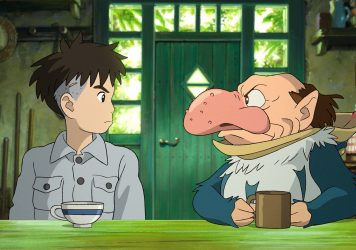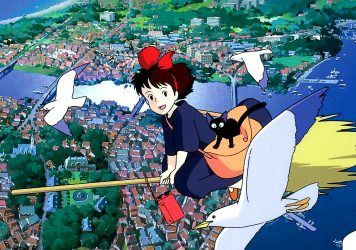
Should it genuinely be the final film in Hayao Miyazaki’s remarkable filmography, The Boy and The Heron won’t be a terrible way to bow out; carrying away Bafta and Academy Awards, grossing around $300 million, and bagging a rare perfect 5-5-5 score when reviewed for this very publication.
That review lauded the film and others in the Studio Ghibli collection for their ‘shifting moralities and motivations’, flexible plotting and inscrutable world rules. Yet conversely, one aspect that consistently characterises much of Miyazaki’s oeuvre – no matter how fantastical the story – is an authentic, tangible sense of location.
It’s not unusual for Miyazaki and Ghibli’s animation department to model these settings on real places; largely, but not necessarily, located in Japan. Yubaba’s bathhouse in Spirited Away is the example that most readily springs to mind, inspired by the 1894-built Dōgo Onsen building. But these deeply authentic roots are always present, from the pan-European seaside cityscapes that backdrop Kiki’s Delivery Service through to the mystical Kushiro wetlands of the Hiromasa Yonebayashi-directed When Marnie Was There.
While Fujimoto’s seafloor dwelling – a coral tower that is, part mad scientist laboratory and part magical marine farm – can only have been trawled from the depths of Miyazaki’s ocean-like imagination, the landlubbing town in 2008’s much-loved Ponyo is another location drawn from the director’s own firsthand experience.
Tomonoura is a town in the centre of the Seto Inland Sea, an hour or so due east of Hiroshima on Japan’s biggest island, Honshu. Flicking through a well-thumbed guidebook during a cherry blossom spotting road trip this spring, I found myself drawn to the promised gorgeous views and treasures of this ‘laconic fishing village’. And when further reading revealed that the port town was portrayed in Ponyo, the Japanese-speaking sat nav was duly set.

Though Miyazaki is a Tokyoite born and bred, he took a pleasure trip to Tomonoura after making Howl’s Moving Castle – and ended up staying for two months. It was in that period that he conjured the basic inspiration for Ponyo.
“There was the bay, docks, and the town sloping up into the mountains,” remembers Noburi Yoshida, the film’s Art Director, in the coffee table book ‘The Art of Ponyo’. “The way we rendered the colour of the not-so-blue sea, and the way the waves surge like huge shadows, were the results of our research trip.”
What’s clear immediately when sweeping around the bay into Tomonoura (not quite at the breakneck speeds that Lisa risks in the film), is that the animation is no faithful recreation. There’s no hulking dry dock or cute retirement home visible. But there are clear reference points to be discovered; ones that the cheerful custodians of the town’s tourist information office are delighted to point out.
Spot number one, they say, is the model for Sôsuke’s idyllic cliff-side abode. Set slap bang in the middle of town rather than out on its own, it’s immediately apparent why it stuck in Miyazaki’s memory: a striking red roof in a sea of black. Yoshida explains, “He’s always liked red triangular roofs and also used them in My Neighbor Totoro. A house on a cliff with an ocean view. While Sôsuke’s house may be an inconvenient place to live (laughs), in a way, it may be an ideal landscape for Miyazaki.”



While the drizzly Honshu skies were enough to keep away many sightseers on the day I visited, the locals have become well accustomed to unfamiliar faces and snapping cameras. “It accounts for more than 20% of the total,” Akihiko Kataoka, Director of the Tomonoura Tourist Information Center, tells me of the proportion of tourists flocking to his workplace in pursuit of Ponyo-based sights. “Nowadays, there are many young tourists, and the number of tourists is increasing worldwide – especially many French, UK and Southeast Asians.”
Indeed, the animation even served as an unlikely source of inspiration for Hollywood location scouts. “Hugh Jackman’s Wolverine: Samurai [released as The Wolverine in the US and UK] also learned about this town from the production website of director Miyazaki’s Ponyo and chose it as a filming location,” says Kataoka.
I’m next pointed along a jetty of bobbing boats towards a craggy set of rocks, that were Miyazaki’s touchstone for the inlet where Sôsuke discovers his fishy friend. It would be disingenuous to say that it’s instantly recognisable, but freighted with that information, one’s imagination immediately visualises a five-year-old boy paddling out to investigate the alluring coral-coloured jar.


It feels uncharitable to wonder where the bustling bay full of trawler boats and fishermen are – wouldn’t Koichi be out there somewhere, flashing Morse-coded messages to Lisa and his son? It’s undoubtedly picturesque, but not the hubbub of activity I had expected.
And yet that’s where the imagination begins to fill in the gaps once more. Imputing magic and meaning into the most benign of features. Perfectly abstract street tiles are suddenly, unmistakably the scales of a fish. The town’s elderly women morph into spitting images of Yoshie, Noriko and the mildly terrifying Toki. And, surely not… do those waves have eyes?


Kataoka-san describes the confidence and pride that Ponyo’s association has given the residents of the town. So it is surprising how little Tomonoura has leant into its connection with the little fish from the deep blue sea. If this was a similar setting on England’s Jurassic or North Sea coast, you feel, the cobbled streets would be lined with ‘Ponyo Experience’ museums, candle-powered boat trips, and family restaurants specialising only in ham. Here the odd Ponyo soft toy and pin badge are massively outnumbered by the amount of products featuring the region’s medicinal-tasting Houmei liquor.
“Time in life is limited,” says Kataoka, “but the beautiful nature and culture of this town will remain in the film.” And, as dusk falls, I realise my own time here is also approaching an end.
Thankfully, my route out of the town reveals two final treasures. The first couldn’t be more obvious, as I drive through a road tunnel that is a clear model for the one in which Ponyo begins to revert to fish form in the film’s last act.
And then, driving just a few minutes more on the other side, the Abuto Kannon where sailors have prayed to the Goddess of Mercy for over a millennium. As the striking Buddhist temple stands sentry, jutting out from a headland over the Seto Inland Sea, it’s only a minnow-sized stretch to associate its crimson lacquered facade with the fiery locks of Granmamare – Ponyo’s matriarchal sea deity. And it’s her serene, compassionate beauty that perhaps gives the most revealing clues as to the streams in Miyazaki’s mind where Ponyo and Tomonoura meet.

Published 13 May 2024

By Anton Bitel
At its heart, Ponyo is a film about a global catastrophe, but the apocalypse has seldom seemed so joyous or tender.

By Mark Asch
Less a swansong and more a heronsong from the Japanese maestro Hayao Miyazaki, a mystical and ambitious message of hope for the future.

In the mid ’80s, the anime stable was struggling following back-to-back box office flops. All that changed with the arrival of a young witch.